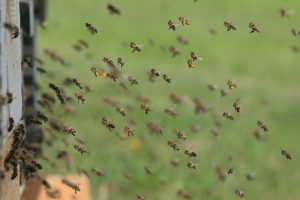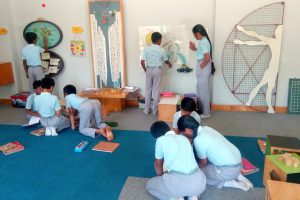“What is a drop of rain, compared to the storm? What is a thought, compared to a mind? Our unity is full of wonder, which your tiny individualism… cannot even conceive.” — The Many, System Shock
Have you ever wondered, why do geese fly in a V formation? As a bird flaps its wings, it reduces resistance in the air/wind, which helps the flock mates behind with a free lift and flying for a longer time. The V shape helps keep track of every bird in the group. So, firstly it saves energy, secondly, it helps with communication and coordination within the group.
Such basic learning from nature is an inspiration for all human inventions. The symmetric V-shaped flight is also called a skein. As it improves the efficiency of flying birds, this is also applied in aerodynamics and military flight missions to improve the fuel efficiency of aircraft.
As they say, two heads are better than one. As teachers and parents, we can apply the “wisdom of geese” in basic learning of kids. What if personalised learning is more about us than me? A mix of personalised and social learning can help students to brainstorm more extensively or challenge each other and come up with better solutions.
Thinking and learning
Teachers play a key role in preparing students with essential skills, healthy competition, and growth mindset that can help them thrive in the future. Group activities in the form of debating or playing help students develop spatial and analytical thinking.
Creating a “team of Individuals”

If the team is effective, then students learn from each other and this learning enables them to accomplish far more, which eventually motivates them further.
For example, learning and working as a team makes them more efficient to compete in bigger projects. Team spirit once again can both inspire and challenge one another in the group.
We have all experienced the thrill of competing as part of a team in debates, elocution, sports and what not with other teams when we were young.
Developing EQ (Emotional Quotient) of your child and preparing her for the real world
As per Wiki, “Emotional intelligence (EI), or Emotional quotient (EQ) is the capability of individuals to recognize their own emotions and those of others, discern between different feelings and label them appropriately, use emotional information to guide thinking and behavior, and manage and/or adjust emotions to adapt to environments or achieve one’s goal(s).”
Simply put, EQ prepares you to succeed in the real world by means of creating empathy and connecting better with other people. Having better EQ is the stepping stone to becoming a leader.
Group activities where experiential learning is involved is proven to improve the EQ of the children.
Social-emotional learning
Social context and interpersonal relations are as important as academic learning for students. This helps them to understand the value of collaboration and feedback, develop empathy, classroom behaviour or even community-minded behaviours in a diverse group. In fact, it can be as basic as leaning to ‘ask for help’ when in trouble.
Preparing students for the new workforce
Looking at the rapid pace of change in the current workplace, Dell Technologies and Institute for the Future (IFTF) – a research and educational organisation on their joint survey highlight that, “About 85% of the jobs that will exist in 2030 haven’t even been invented yet… In other words, get ready for a lifetime of skills training and retraining, in real time.”
What can we do (and plan to do)?
Schools can ensure to provide young minds with new learning spaces, necessary hands-on learning opportunities and real-life experience to become tomorrow’s innovators, inventors and be able to flourish in a rapidly changing world.
Experiential learning focusing on 5C based concepts helps the overall growth of the students. Students here many times work as a team to solve the problems through effective interaction and communication.

Blended Learning, where the experiential learning is combined with the reinforcement power of technology make the hive mind much coherent.
tl;dr
When group objectives are kept in mind and each student is encouraged to think accordingly, collective consciousness or collective intelligence provide exciting opportunities to learn. It also helps greatly in communication and connectivity aspects.
(Cover Image credits – Pixabay/Kai Kalhh)
Parimita Krishna
Latest posts by Parimita Krishna (see all)
- How Personalised Learning can make your kids curious? - 14 June 2019
- What’s new in CBSE and why Experiential Learning is even more relevant? - 31 May 2019
- The Curious Case of Homeschooling in India - 5 April 2019
- Making Maths fun for your kids - 8 March 2019
- Blended Learning: A Perspective on “Learning how to Learn” - 22 February 2019

